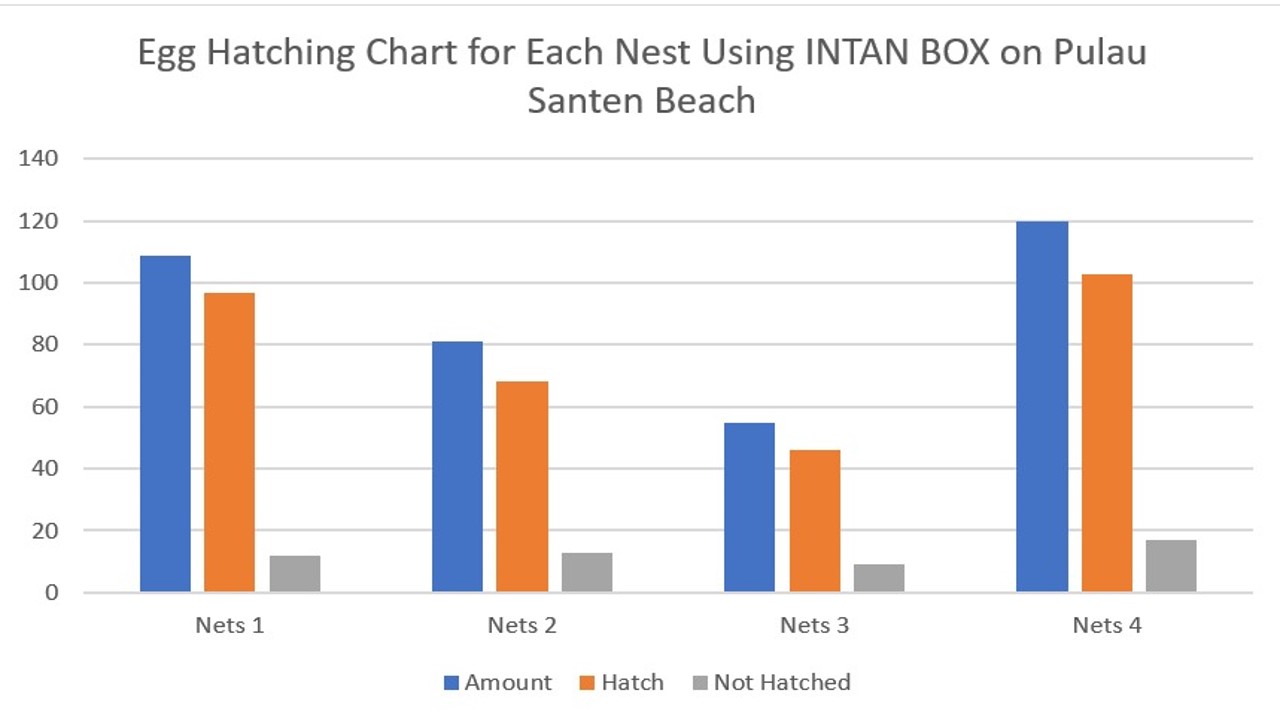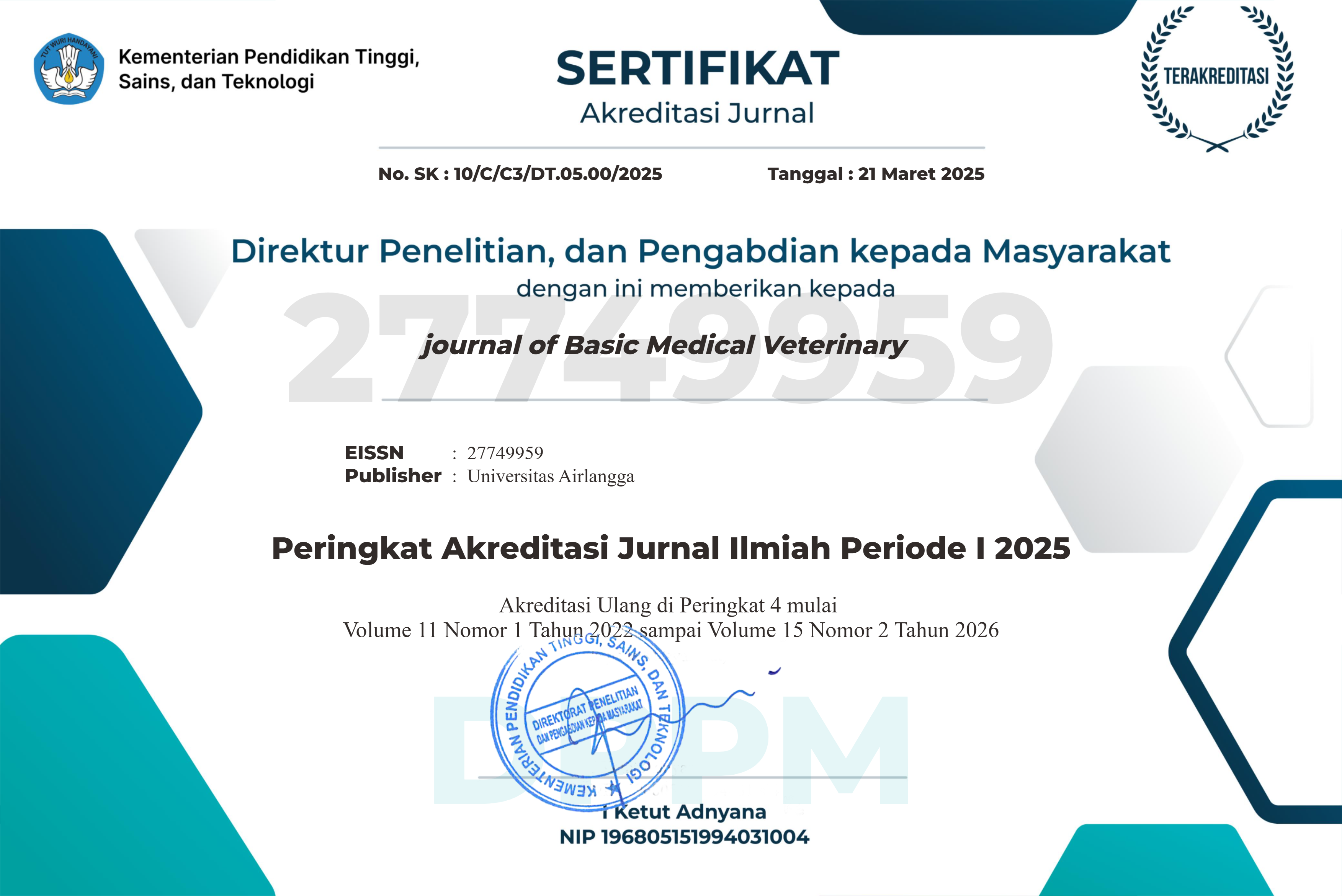Hatchability Success Rate of Olive Ridley Sea Turtle (Lepidochelys olivacea) Eggs Using the INTAN BOX Incubation Device on Pulau Santen Beach, Banyuwangi

Downloads
The natural hatching success rate of olive ridley sea turtle (Lepidochelys olivacea) eggs on Pulau Santen Beach is often hindered by predator disturbances, temperature fluctuations caused by human activities, and unfavorable environmental conditions, with a success rate of only 50–70%. This study aimed to analyze the hatching success rate of olive ridley sea turtle eggs using the INTAN BOX incubation device on Pulau Santen Beach, Banyuwangi. A quantitative descriptive method was employed to observe 365 eggs relocated from four nests to the INTAN BOX over an incubation period of 50–60 days. Parameters observed included temperature, humidity, and hatching success rates. Results indicated an average hatching success rate of 86%, with individual nest success rates ranging from 83% to 89%. These rates are significantly higher than the 50–70% success rate achieved through natural hatching. The INTAN BOX provides a stable environment, protects eggs from predators, and optimizes temperature and humidity conditions, thereby enhancing hatching success. Additionally, the device enables the management of hatchling sex ratios through temperature-dependent sex determination (TSD), which is critical for sea turtle population conservation. This study concluded that the INTAN BOX is an effective innovation for olive ridley turtle conservation while also supporting local community empowerment around Pulau Santen Beach.
Ackerman, R.A., 1997. The role of temperature in determining the sex ratio of hatchling sea turtles. In: J.A. Musick and C.J. Limpus, eds. The biology of sea turtles. Boca Raton: CRC Press, pp. 63–87.
Ageng, M.A., 2018. Cemaran mikroba pada telur penyu sisik (Eretmochelys imbricata) di Pulau Kelapa Dua, Taman Nasional Laut Kepulauan Seribu, DKI Jakarta. Jurnal Al-Azhar Indonesia Seri Sains dan Teknologi, 4(2), 83.
Al-Bahry, S.N., Mahmoud, I., Elshafie, A., AlHarthy, A., Al-Ghafri, S., Al-Amri, I. and Alkindi, A., 2011. Bacterial flora and antibiotic resistance from eggs of green turtles (Chelonia mydas): An indication of polluted effluents. Marine Pollution Bulletin, 58, 720–725.
Ayuningtyas, I., Kushartono, E.W. and Redjeki, S., 2019. Identifikasi jamur pada tukik Lepidochelys olivacea, Eschscholtz, 1829 (Reptilia: Cheloniidae) di Turtle Conservation and Education Center Bali. Journal of Marine Research, 8(2), 157–167.
Azaria, D., 2014. Perlindungan lingkungan laut Samudra Pasifik dari gugusan sampah plastik berdasarkan hukum lingkungan internasional. Doctoral dissertation, Universitas Brawijaya.
Convention on International Trade in Endangered Species of Wild Fauna and Flora (CITES), 2022. The CITES species. Available at: https://cites.org/eng/disc/species.php [Accessed 5 May 2024].
Haditanojo, W., 2024. Alat Penetas Telur Penyu Tanpa Media Pasir. Paten Indonesia No. IDS000007996. Diberikan pada 7 Mei 2024.
IUCN, 2022. The IUCN Red List of Threatened Species Version 2022-2. Available at: https://www.iucnredlist.org/ [Accessed 1 June 2024].
Kurniawan, D., Putra, R. and Suryani, A., 2021. The use of artificial incubators for sea turtle conservation in coastal areas. Journal of Marine Biology and Conservation, 14(2), 105–112.
Mauboy, R.S., Dima, O.M., Ruma, M.T. and Karyawati, A., 2022. Isolasi dan karakterisasi bakteri pada pasir sarang, cairan kloaka, dan cangkang telur penyu lekang (Lepidochelys olivacea L.). Jurnal Biotropikal Sains, 19(2).
Praja, R.N., Yudhana, A., Haditanojo, W. and Oktaviana, V., 2021. Antimicrobial properties in cloacal fluid of olive ridley sea turtle (Lepidochelys olivacea). Biodiversitas, 22(9), 3671–3676.
Putra, R., Santoso, A. and Kurniawan, D., 2020. Conservation efforts of sea turtles in tropical coastal areas. Journal of Marine Conservation, 12(3), 211–220.
Samosir, S.H., Hernawati, T., Yudhana, A. and Haditanojo, W., 2018. Perbedaan sarang alami dengan semi alami mempengaruhi masa inkubasi dan keberhasilan menetas telur penyu lekang (Lepidochelys olivacea) pantai Boom Banyuwangi. Jurnal Medik Veteriner, 1(2), 33–37.
Sari, W. and Ilyosa, A.N., 2020. Pengaruh kedalaman sarang dan jumlah telur terhadap keberhasilan penetasan dan kemunculan tukik Lepidochelys olivacea di Pantai Apar Pariaman. Prosiding Seminar Nasional Biologi, Teknologi dan Kependidikan, 8(1).
Wicaksono, M.A., Nurhasanah, F., Elfidasari, D. and Sugoro, I., 2018. Cemaran mikroba pada telur penyu sisik (Eretmochelys imbricata) di Pulau Kelapa Dua, Taman Nasional Laut Kepulauan Seribu, DKI Jakarta. Jurnal Al-Azhar Indonesia Seri Sains dan Teknologi, 4(2), 83–90.
Wicaksono, T., 2018. Natural nesting success of olive ridley sea turtles on sandy beaches. Journal of Environmental Studies, 15(1), 98–107.
Yntema, C.L. and Mrosovsky, N., 1979. Sexual differentiation in hatchling loggerhead sea turtles (Caretta caretta) incubated at different temperatures. Herpetologica, 35(1), 33–36.
Yudhana, A., Firmansyah, J., Praja, R.N., Yulianti, Y.T., Sari, J.D.E., Mandagi, A.M., Hadinatojo, W. and Hamonangan, J.M., 2023. Edutourism initiative in Pulau Santen Beach, Banyuwangi through local community empowerment by sea turtle conservation program. Journal of Basic Medical Veterinary, 12(2), 100–111.
Yudhana, A., Purnama, M.T.E., Kenconojati, H., Praja, R.N., Putri, C.K., Geraldine, A.P., Zania, F.O., Galerani, I.A. and Putri, A.R.B., 2023. Optimalization of sea turtle and coastal vegetation conservation through empowerment in Pulau Santen tourism aware group, Banyuwangi Regency, East Java. Jurnal Layanan Masyarakat, 7(2), 275–283.
Yulianto, S. and Sari, A., 2019. Factors influencing hatching success of sea turtle eggs in semi-natural hatcheries. Marine Biology Review, 18(4), 445–460.
Copyright (c) 2025 Aditya Yudhana, Jayanti Dian Eka Sari, Ratih Novita Praja, Akbar Dimas Herdiansyah, Diza Ulya Nurfaizah, Reza Adrio Farezi, Bintang Muslimah, Septa Indra Puspikawati, Hapsari Kenconojati, Soetojo Soetojo, Rahadian Indarto Susilo, Mufasirin Mufasirin, Wiyanto Haditanojo, Bayu Saksono, Gerda Sukarno

This work is licensed under a Creative Commons Attribution-ShareAlike 4.0 International License.
Journal of Basic Medical Veterinary (JBMV) by Unair is licensed under a Creative Commons Attribution-ShareAlike 4.0 International License.
1. The journal allows the author to hold the copyright of the article without restrictions.
2. The journal allows the author(s) to retain publishing rights without restrictions
3. The legal formal aspect of journal publication accessibility refers to Creative Commons Attribution Share-Alike (CC BY-SA).
4. The Creative Commons Attribution Share-Alike (CC BY-SA) license allows re-distribution and re-use of a licensed work on the conditions that the creator is appropriately credited and that any derivative work is made available under "the same, similar or a compatible license”. Other than the conditions mentioned above, the editorial board is not responsible for copyright violation.







 Perhimpunan Dokter Hewan Indonesia
Perhimpunan Dokter Hewan Indonesia








